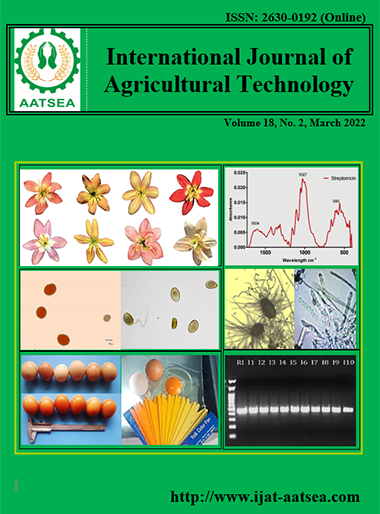Simultaneous and sensitive detection of CVB, CChMVd and CSVd mixed infections in chrysanthemum using multiplex nested RT-PCR
Main Article Content
Abstract
Chrysanthemum plants are susceptible to infect by viral and viroid diseases. Early detection of these pathogens helps to prevent disease spread. Multiplex RT-PCR can simultaneously detect many virus and viroid in a single reaction, and applying multiplex nested PCR can improve the sensitivity of the detection. Chrysanthemum leaves were collected from cultivation areas in Northern Thailand. Multiplex nested RT-PCR using specific outer and inner primer pairs for detection of Chrysanthemum virus B (CVB), Chrysanthemum chlorotic mottle viroid (CChMVd), and Chrysanthemum stunt viroid (CSVd) were used for simultaneous detection. Among 15 randomly selected samples, one sample showed co-infections of CVB and CChMVd, and two samples showed multiple infections of all pathogens. Furthermore, multiplex nested RT-PCR detected amplicons of CChMVd and CSVd that were not detected by the first-round PCR. Also, sequence analysis was used to confirm the correction of amplified fragments and revealed that all amplicons were more than 93% identical compared to corresponding sequences deposited in the GenBank. Therefore, multiplex nested RT-PCR can be used for routine detection and diagnosis of virus and viroid diseases. This is the first detection of mixed infections (disease complex) both virus and viroid in the chrysanthemum of Thailand.
Article Details

This work is licensed under a Creative Commons Attribution-NonCommercial-NoDerivatives 4.0 International License.
References
Anna, K. W., Raymond, C. C., Nidhi, A., Manoj, K. S., Stephen, N. W. and Shikha, B. (2010). Human papillomavirus genotypes in anal intraepithelial neoplasia and anal carcinoma as detected in tissue biopsies. Modern Pathology, 23:144-150.
Bertolini, E., Olmos, A., Loopez, M. M. and Cambra, M. (2002). Multiplex nested reverse transcription-polymerase chain reaction in a single tube for sensitive and simultaneous detection of four RNA viruses and Pseudomonas savastanoi pv. savastanoi in olive trees. Phytopathology, 93:286-293.
Cho, W. K., Jo, Y., Jo, K. M. and Kim, K. H. (2013). A current overview of two viroids that infect chrysanthemums: Chrysanthemum stunt viroid and Chrysanthemum chlorotic mottle viroid. Viruses, 5:1099-1113.
Chung, B. N., Lim, J. H., Choi, S. Y., Kim, J. S. and Lee, E. J. (2005). Occurrence of Chrysanthemum stunt viroid in chrysanthemum in Korea. Plant Pathal Journal, 21:377-382.
Chung, B. N. and Pak, H. S. (2008). Seed transmission of Chrysanthemum stunt viroid in chrysanthemum (Dendranthema grandiflorum) in Korea. Plant Pathology Journal, 24: 31-35.
Dimock, A. W., Geissinger, C. M. and Horst, H. K. (1971). Chlorotic mottle: a newly recognized disease of chrysanthemum. Phytpathology, 61:415-419.
Ebata, M., Matsushita, Y., Morimoto, M. and Mochizuki, T. (2019). Distribution of Chrysanthemum chlorotic mottle viroid in shoot meristem and flower buds of chrysanthemum. European Journal of Plant Pathology, 154:555-563.
Flores, R., Hernandez, C., Martinez de Alba, A. E., Daros, J. A. and Di Serio, F. (2005). Viroids and viroid-host interactions. Annual Review of Phytopathology, 43:117-139.
Guan, Z., Wu, D., Song, A., Chen, F., Chen, S. and Fang, W. (2017). A highly sensitive method for the detection of Chrysanthemum virus B. Electronic Journal of Biotechnology, 26:64-68.
Hosokawa, M., Otake, A., Ohishi, K., Ueda, E., Hayashi, T. and Yazawa, S. (2004). Elimination of Chrysanthemum stunt viroid from an infected chrysanthemum cultivar by shoot regeneration from a leaf primordium-free shoot apical meristem dome attached to a root tip. Plant Cell Reports, 22:859-863.
Hosokawa, M., Shiba, H., Kawabe, T., Nakashima, A. and Yazawa, S. (2007). A simple and simultaneous detection method for two different viroids infecting chrysanthemum by multiplex direct RT-PCR. Journal of Japanese Society for Horticultural Science, 76:60-65.
Jinxia, A., Qingzhang, L., Xuejun, G., Yanbo, Y., Lu, L. and Minghui, Z. (2011). A multiplex nested PCR assay for simultaneous detection of genetically modified soybean, maize and rice in highly processed products. Food Control, 22:1617-1623.
Kumar, S., Li, G., Stecher, M., Knyaz, C. and Tamura, K. (2018). MEGA X: Molecular Evolutionary Genetics Analysis across computing platforms. Molecular Biology and Evolution, 35:1547-1549.
Matsushita, Y. (2013). Chrysanthemum stunt viroid. Japan Agricultural Research Quarterly, 47:237-242.
Navarro, B. and Flores, R. (1997). Chrysanthemum chlorotic mottle viroid: unusual structural properties of a subgroup of self-cleaving viroids with hammerhead ribozymes. Proceedings of the National Academy of Sciences of the United States of America, 94:11262-11267.
Netwong, C., Reanwarakorn, K. and Tansuwan, K. (2020). Detection of Chrysanthemum stunt viroid (CSVd) from naturally infected Chrysanthemum in Wang Nam Khiao District. Thai Agricultural Research Journal, 38:23-32 (in Thai).
Ohkawa, A., Suehiro, N. I., Okuda, S. and Natsuaki, T. (2008). Construction of an infectious full-length cDNA clone of Chrysanthemum virus B. Journal of General Plant Pathology, 74:434-437.
Seigner, L., Liebrecht, M., Keckel, L., Einberger, K. and Absmeier, C. (2020). Real‐time RT‐PCR detection of Citrus bark cracking viroid (CBCVd) in hops including an mRNA‐based internal positive control. Journal of Plant Diseases and Protection, 127:763-767.
Singh, L., Hallan, V., Jabeen, N., Singh, A. K., Ram, R., Martin, D. P. and Zaidi, A. A. (2007). Coat protein gene diversity among Chrysanthemum virus B isolates from India. Archives of Virology, 152:405-413.
Song, A., You, Y., Chen, F., Li, P., Jiang, J. and Chen, S. (2012). A multiplex RT-PCR for rapid and simultaneous detection of viruses and viroids in chrysanthemum. Letters in Applied Microbiology, 56:8-13.
Yamamoto, H. and Sano, T. (2005). Occurrence of Chrysanthemum chlorotic mottle viroid in Japan. Journal of General Plant Pathology, 71:156-157.
Zhao, X., Liu, X., Ge, B., Li, M. and Hong, B. (2015). A multiplex RT-PCR for simultaneous detection and identification of five viruses and two viroids infecting chrysanthemum. Archives of Virology, 160:1145-1152.


